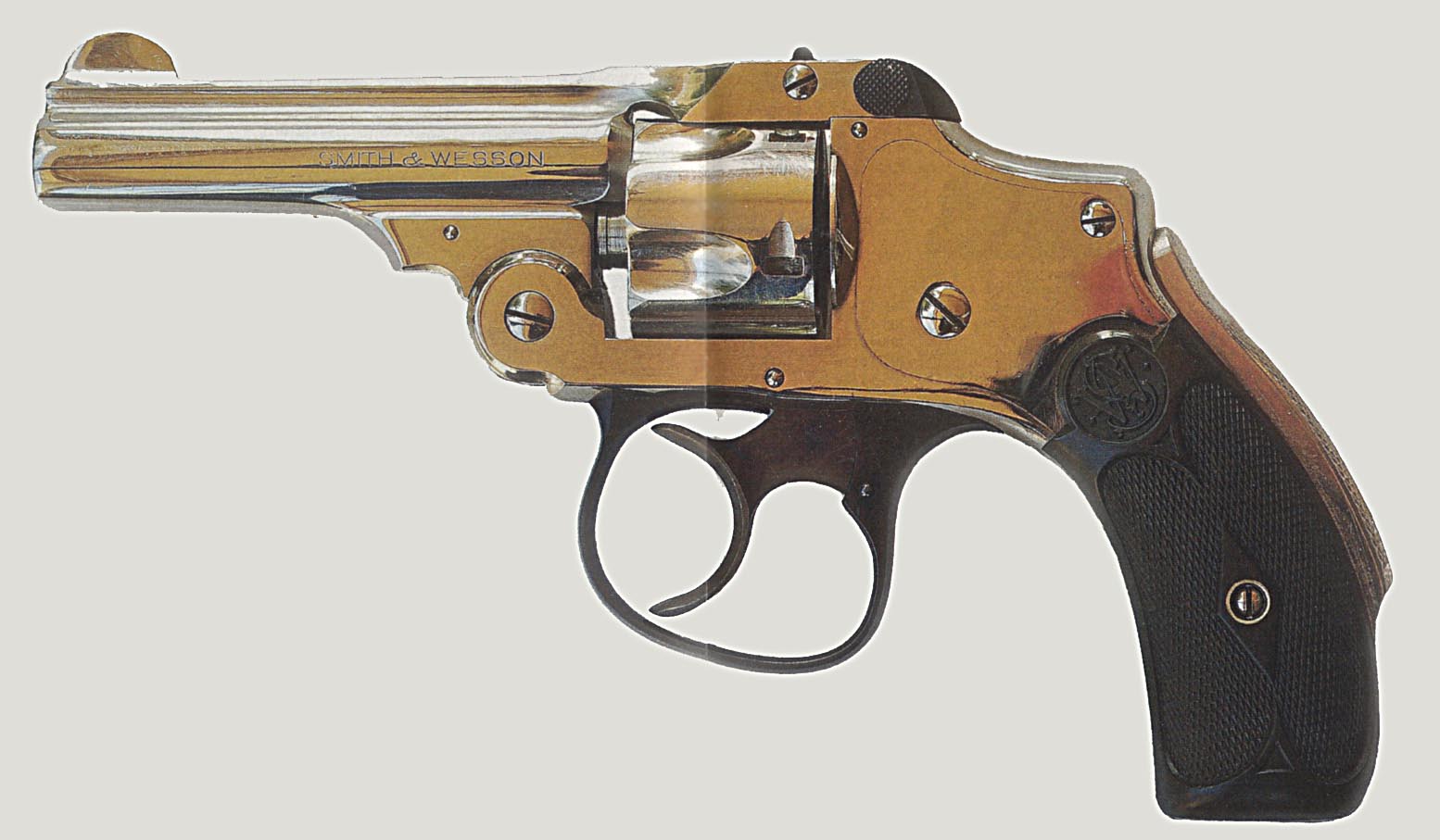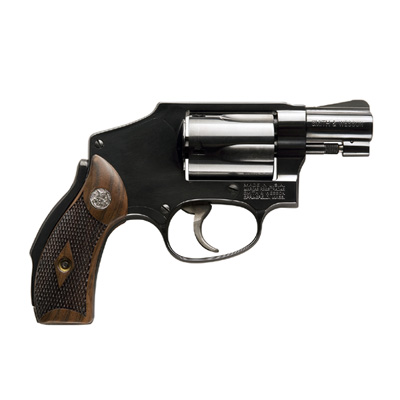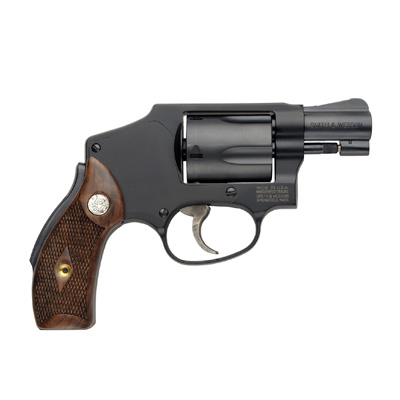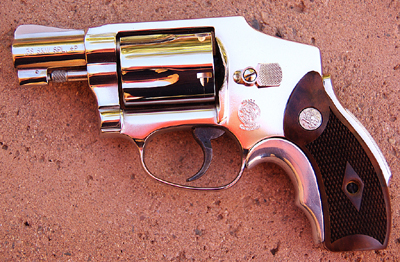Johnny Dollar's Lemon Squeezer
Hume Alumni Main Page,
Second Edition Home Page
The Original YTJD Errata Page,
The Second Edition Errata Page,
The Writers and Producers,
My Bob Bailey Page,
My Charles Russell Page,
YTJD Announcers
All hard-core Johnny Dollar listeners know that the Bob Bailey era Johnny carried a "lemon squeezer". But just what is a "lemon squeezer"? While reading through my co-worker's October, 2010 issue of "The Blue Press", I spotted an article with what to me was a familiar picture - a Smith & Wesson hammerless revolver - commonly called a "lemon squeezer". I contacted the author and the publisher and have obtained their permission to include their article here.
CLASSIC HANDGUNS: The S&W Safety Hammerless Revolvers
By John Marshall
During the 1880s, Smith & Wesson co-founder Daniel Baird Wesson was seeking to design and produce a revolver for self defense that would be entirely safe to handle until properly gripped and fired by a long, heavy double-action pull on the trigger. He was particularly motivated by reports of children firing guns accidentally. Such a revolver would have no external hammer, and could not therefore be fired with a light single-action pull. D.B. Wesson began work on the project with his son Joe, and the result was the first in a long line of double-action-only self-defense revolvers. These would be extremely difficult for a child to fire. Such guns would have an additional advantage for law enforcement officers, who could draw their revolver from underneath clothing without a hammer catching on a pocket or coat and impeding the draw. This concept lives on in some modern S&W revolvers. Today these early revolvers, named by the factory "Safey Hammerless" or "New Departure" are classic collector items.
D.B. Wesson assigned the development of the new revolver to his son Joe, and this was one of Joe's first drafting projects. Joseph H. Wesson had learned a lot from his father, and had inherited much of his forebear's mechanical aptitude. His first model design was completed on May 1, 1884. In addition to it being a double-action-only revolver it incorporated a grip safety in the backstrap of the firearm. Gripping the revolver tightly deactivated an internal hammer block, and allowed the gun to be fired. This first design did have a flaw. It featured a heavy striker bar. Unfortunately, if the gun was dropped on its muzzle the forward inertia of the striker bar could allow it to strike the primer, sometimes firing the gun accidentally. Joe Wesson went back to the drawing board and came up with a second concept in January 1886 that eliminated this problem. This design utilized a much smaller spring-loaded inertia-type firing pin that could only ignite a primer if it was struck a strong blow by the internal hammer. Being spring-loaded, it automatically retracted after being struck, and did not continue to touch the primer even while the hammer was at rest against the pin. John Browning later utilized this nearly identical system for his enduring Model 1911 .45 pistol design.
Initial plans were to produce the new revolver in calibers .32 S&W, .38 S&W, and .44 S&W Russian, and early advertisements stated these intentions. However after producing a prototype, it was decided to make them only in the two lesser calibers. The first guns manufactured were known as .38 Safety Hammerless models, and eight nickeled revolvers were produced in July 1886. Twenty more nickeled revolvers were made in August of that year, and these guns were held in inventory until February 1887, when production and distribution began in earnest. Over the life of the .38 Safety Hammerless models, five distinct model variations were generated, differing primarily in the barrel locking systems. All, of course, were of "top break" design where the cartridges or empties were ejected automatically when the barrel and cylinder were released and swung down. During its production life, this arm was made with either a blue or nickel finish, and was offered in a wide range of barrel lengths from 2" to 6". Production ceased on the .38 model in 1940, with a final serial number of 261,493.
S&W tooled up and began producing the.32 Safety Hammerless models in February, 1888 when 16 nickeled revolvers were made. The improvements made to the latching mechanism on the .38 models were incorporated on the .32, the first ones being essentially reduced-size versions of the .38 Third Model. Three different model variations were made in the .32 revolver over its production life. These changes involved improvements to the barrel catch, the front sight, and the cylinder base pin attachment. Almost all were equipped with black rubber stocks, although as with the .38s, stocks of other material, were available from the factory on special order. At first, the .32s were offered only with 3 and 3.5" barrel lengths. In 1898, the "bicycle gun" variation with a 2" barrel came out and was popular with cyclists wishing protection against canines wishing to do battle with their velocipedes. These 2" guns are scarce and collector values are quite high today.

The revolver illustrated for this article is a .32 Safety Hammerless Third Model, nickel finish, with the more common 3" barrel. It left the factory in November 1921, and carries a serial number in the early 223,000 range. In nearly perfect shape, it appears unfired and is accompanied by a correct factory box. Because of its condition, I suspect that it resided in someone's dresser drawer for many years after being purchased. A factory authenticating letter shows it was initially shipped to a large popular hardware store of that era. The final or Third Model was made from 1909 until 1937, with an ending serial number of 242,981.
Interestingly, although the factory always referred to these revolvers as the "Safety Hammerless" models, the factory cardboard box labels were imprinted with the words "New Departure." This was apparently because Smith & Wesson wanted to differentiate these "hammerless" revolvers as being a departure from the norm of double/single-action guns. In spite of these two different factory nomenclatures, today these revolvers are popularly and affectionately known as "Lemmon Squeezers" because of their grip safety and the genre's similar action to a once-common kitchen utensil of the same name.
Smith & Wesson's top-break revolvers, introduced way back in 1870, lasted well into the 20th Century and were imitated by other manufacturers worldwide. The .38 Safety Hammerless was the final mark of that S&W breed, but its influence continues on to the present day. In 1952, S&W introduced its Centennial Model revolver, so named because it commemorated the 100th year of the company's history. It was a .38 Special J-frame 2" barreled revolver with no external hammer. It had a grip safety almost identical to that used on the Safety Hammerless models. This was a swing-out cylinder type, of course, but the concept was very much in line with the immensely successful "Lemon Squeezer" which was its ancestor. In fact, that nickname stuck with the newer gun, as well. The Centennial Airweight model with an aluminum frame was also introduced in 1952, with full-scale production beginning in August 1963. At first the Airweights had aluminum cylinders, but were replaced with steel cylinders quickly for safety reasons. The Centennials and the Centennial Airweights became the Models 40 and 42 in 1957, when model names were replaced by model numbers at the factory. These two revolvers were dropped from the S& W lineup in 1974. Model 640 stainless steel Cenntenials, with no grip safety have been made since 1989 and the Model 642 Centennial Air weights (aluminum frame and stainless cylinder) since 1990. The blackened aluminum/stainless Model 442 Centennial Airweight came on stream in 1993.
 |
 |
 |
S&W Model 40 | S&W Model 42 |
Nickel-plated Model 40-1 Courtesy of, |
In late 2007 an updated and strengthened all-carbon steel Model 40 was introduced as the Model 40-1, available in blue, nickel, and case-hardened finishes. These revolvers are complete with grip safeties and their heritage goes back to the original Safey Hammerless models of 1886! Unlike many other revolvers in the Smith & Wesson lineup, the new Model 40-1 has no politically correct internal key-lock on the left side of the frame.
The original Safety Hammerless revolvers introduced a genre that survives to the present day. Popular in their time, good-condition specimens are still quite desirable on the collector market, and excellent examples, particularly if accompanied an an original box and papers, are quite valuable. They are all classics!
So, based on the above information, when Johnny pulls out his "lemon squeezer", picture him pulling out a Model 40 - probably a nickel-plated model very similar to the Model 40-1 shown above, because as was noted in "The Deadly Swamp Matter," his gun was a "pretty one".
If you want more information, e-mail the author at: |
 |